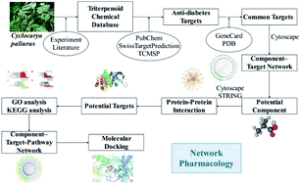We are very pleased to introduce Junmin Li, corresponding author of the paper ‘Network pharmacology-based study of the mechanisms of action of anti-diabetic triterpenoids from Cyclocarya paliurus‘. Her article has been very well received and handpicked by our reviewers and handling editors as one of our October HOT articles. Junmin told us more about the work that went into this article and what she hopes to achieve in the future. You can find out more about the author and her article below and find more HOT articles in our online collection.
Meet the authors
 Junmin Li was born in Linhai, Zhejiang Province, China in December, 1973. She mainly specialized in the study of evolutionary ecology, molecular ecology and the development of medicinal and edible plant resources. She is the director of Zhejiang Provincial Key Laboratory of Plant Evolutionary Ecology and Conservation, the person in charge of Plant Evolutionary Ecology Innovation Team of High Level in Provincial Colleges and Universities. She also holds an additional post as Vice Director of Biological Invasions Ecology in Ecological Society of China, a committee member of the Population Ecology in Ecological Society of China, Vice President of Botanical Society of Zhejiang Province.
Junmin Li was born in Linhai, Zhejiang Province, China in December, 1973. She mainly specialized in the study of evolutionary ecology, molecular ecology and the development of medicinal and edible plant resources. She is the director of Zhejiang Provincial Key Laboratory of Plant Evolutionary Ecology and Conservation, the person in charge of Plant Evolutionary Ecology Innovation Team of High Level in Provincial Colleges and Universities. She also holds an additional post as Vice Director of Biological Invasions Ecology in Ecological Society of China, a committee member of the Population Ecology in Ecological Society of China, Vice President of Botanical Society of Zhejiang Province.
Could you briefly explain the focus of your article to the non-specialist (in one or two sentences only) and why it is of current interest?
In this study, we applied the network pharmacological approach to investigate the main target proteins of Cyclocarya paliurus triterpenoids with anti-diabetes activity by constructing a target interaction network, and used molecular docking methods to validate the key findings.
At present, diabetes is treated with drugs, such as sulfonylureas, DPP-4 inhibitors and oralantidiabetic agents but many drugs have side effects. Therefore, it is urgent to find new, safe and effective early intervention medicinal compounds for diabetes. Cyclocarya paliurus, a recently confirmed new food resource, shows significant hypoglycemic and hypolipidemic effects in type II diabetes. By using network pharmacology, we can explore the mechanisms of action of Cyclocarya paliurus triterpenoids at the molecular level.
How big an impact could your results potentially have?
In our study, 7 triterpenoids, 15 target proteins, and 15 signaling pathways were found to play important roles in the therapeutic effects of Cyclocarya paliurus against diabetes. These results could provide the potential target compounds for researchers and predict the possible mechanisms.
Could you explain the motivation behind this study?
Diabetes is a complex illness requiring long-term therapy. Cyclocarya paliurus, a recently confirmed new food resource, shows significant hypoglycemic and hypolipidemic effects in type II diabetes. Triterpenoid saponins are considered as the effective medicinal components of Cyclocarya paliurus and are useful for the treatment of diabetes mellitus. However, little is known regarding their specific mechanism of actions. By using network pharmacological approach, we can explore the mechanisms of action of anti-diabetic triterpenoids from Cyclocarya paliurus.
In your opinion, what are the key design considerations for your study?
Our study focused on the correlation between Cyclocary paliurus triterpenoids and anti-diabetes activity. The key design is the network pharmacology analysis of the main target proteins of Cyclocarya paliurus triterpenoids and biological process and pathway enrichment analysis of the target proteins of the active ingredients of Cyclocarya paliurus.
Which part of the work towards this paper proved to be most challenging?
The biggest challenge is to collect isolated triterpenoids from Cyclocarya paliurus in the literature and analyze the mechanism of action of core targets in the treatment of diabetes. Both of these tasks require a lot of time and effort to read a large amount of literature. And we also added the triterpenoids isolated in our lab.
What aspect of your work are you most excited about at the moment?
Our results indicate that seven compounds show potential for the treatment of diabetes. These triterpene compounds were predicted to interact with PTGS2, VEGFA, CASP3, and other enzymes. These results provide valuable insights into the synergistic mechanism of action of natural medicines.
What is the next step? What work is planned?
The next work is doing in vivo or in vitro experiments to verify the effects of seven teriterpene compounds on target proteins and there effect of anti-diabetes. And we also want to dissect the biosynthetic pathway of the seven teriterpene compounds.
Network pharmacology-based study of the mechanisms of action of anti-diabetic triterpenoids from Cyclocarya paliurus
Zixin Lin, Yingpeng Tong, Na Li, Ziping Zhu and Junmin Li
RSC Adv., 2020,10, 37168-37181
DOI: 10.1039/D0RA06846B, Paper
 Submit to RSC Advances today! Check out our author guidelines for information on our article types or find out more about the advantages of publishing in a Royal Society of Chemistry journal.
Submit to RSC Advances today! Check out our author guidelines for information on our article types or find out more about the advantages of publishing in a Royal Society of Chemistry journal.
Keep up to date with our latest HOT articles, Reviews, Collections & more by following us on Twitter. You can also keep informed by signing up to our E-Alerts.











